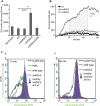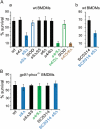Candida albicans cell surface superoxide dismutases degrade host-derived reactive oxygen species to escape innate immune surveillance
- PMID: 19019164
- PMCID: PMC2713856
- DOI: 10.1111/j.1365-2958.2008.06528.x
Candida albicans cell surface superoxide dismutases degrade host-derived reactive oxygen species to escape innate immune surveillance
Abstract
Mammalian innate immune cells produce reactive oxygen species (ROS) in the oxidative burst reaction to destroy invading microbial pathogens. Using quantitative real-time ROS assays, we show here that both yeast and filamentous forms of the opportunistic human fungal pathogen Candida albicans trigger ROS production in primary innate immune cells such as macrophages and dendritic cells. Through a reverse genetic approach, we demonstrate that coculture of macrophages or myeloid dendritic cells with C. albicans cells lacking the superoxide dismutase (SOD) Sod5 leads to massive extracellular ROS accumulation in vitro. ROS accumulation was further increased in coculture with fungal cells devoid of both Sod4 and Sod5. Survival experiments show that C. albicans mutants lacking Sod5 and Sod4 exhibit a severe loss of viability in the presence of macrophages in vitro. The reduced viability of sod5Delta/Delta and sod4Delta/Deltasod5Delta/Delta mutants relative to wild type is not evident with macrophages from gp91phox(-/-) mice defective in the oxidative burst activity, demonstrating a ROS-dependent killing activity of macrophages targeting fungal pathogens. These data show a physiological role for cell surface SODs in detoxifying ROS, and suggest a mechanism whereby C. albicans, and perhaps many other microbial pathogens, can evade host immune surveillance in vivo.
Figures






Similar articles
-
Copper-only superoxide dismutase enzymes and iron starvation stress in Candida fungal pathogens.J Biol Chem. 2020 Jan 10;295(2):570-583. doi: 10.1074/jbc.RA119.011084. Epub 2019 Dec 5. J Biol Chem. 2020. PMID: 31806705 Free PMC article.
-
Superoxide dismutases in Candida albicans: transcriptional regulation and functional characterization of the hyphal-induced SOD5 gene.Mol Biol Cell. 2004 Feb;15(2):456-67. doi: 10.1091/mbc.e03-03-0179. Epub 2003 Nov 14. Mol Biol Cell. 2004. PMID: 14617819 Free PMC article.
-
Extracellular superoxide dismutase protects Histoplasma yeast cells from host-derived oxidative stress.PLoS Pathog. 2012;8(5):e1002713. doi: 10.1371/journal.ppat.1002713. Epub 2012 May 17. PLoS Pathog. 2012. PMID: 22615571 Free PMC article.
-
Epigenetic Control of Oxidative Stresses by Histone Acetyltransferases in Candida albicans.J Microbiol Biotechnol. 2018 Feb 28;28(2):181-189. doi: 10.4014/jmb.1707.07029. J Microbiol Biotechnol. 2018. PMID: 29169224 Review.
-
Oxidative stress responses in the human fungal pathogen, Candida albicans.Biomolecules. 2015 Feb 25;5(1):142-65. doi: 10.3390/biom5010142. Biomolecules. 2015. PMID: 25723552 Free PMC article. Review.
Cited by
-
The role of Candida albicans AP-1 protein against host derived ROS in in vivo models of infection.Virulence. 2013 Jan 1;4(1):67-76. doi: 10.4161/viru.22700. Virulence. 2013. PMID: 23314569 Free PMC article.
-
Histoplasma capsulatum surmounts obstacles to intracellular pathogenesis.FEBS J. 2016 Feb;283(4):619-33. doi: 10.1111/febs.13389. Epub 2015 Nov 25. FEBS J. 2016. PMID: 26235362 Free PMC article. Review.
-
Essential metals at the host-pathogen interface: nutritional immunity and micronutrient assimilation by human fungal pathogens.FEMS Yeast Res. 2015 Nov;15(7):fov071. doi: 10.1093/femsyr/fov071. Epub 2015 Aug 4. FEMS Yeast Res. 2015. PMID: 26242402 Free PMC article. Review.
-
CARD9 deficiencies linked to impaired neutrophil functions against Phialophora verrucosa.Mycopathologia. 2015 Jun;179(5-6):347-57. doi: 10.1007/s11046-015-9877-2. Epub 2015 Mar 20. Mycopathologia. 2015. PMID: 25790941
-
Immunopathology of Recurrent Vulvovaginal Infections: New Aspects and Research Directions.Front Immunol. 2019 Aug 28;10:2034. doi: 10.3389/fimmu.2019.02034. eCollection 2019. Front Immunol. 2019. PMID: 31555269 Free PMC article. Review.
References
-
- Akira S, Uematsu S, Takeuchi O. Pathogen recognition and innate immunity. Cell. 2006;124:783–801. - PubMed
-
- Babior BM. NADPH oxidase. Curr Opin Immunol. 2004;16:42–47. - PubMed
-
- Brown GD, Gordon S. Immune recognition of fungal [beta]-glucans. Cell Microbiol. 2005;7:471–479. - PubMed
-
- Chauhan N, Latge JP, Calderone R. Signalling and oxidant adaptation in Candida albicans and Aspergillus fumigatus. Nat Rev Microbiol. 2006;4:435–444. - PubMed
-
- Dahlgren C, Karlsson A. Respiratory burst in human neutrophils. J Immunol Meth. 1999;232:3–14. - PubMed
Publication types
MeSH terms
Substances
LinkOut - more resources
Full Text Sources
Other Literature Sources
Molecular Biology Databases

